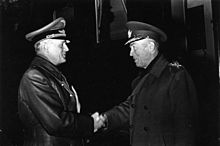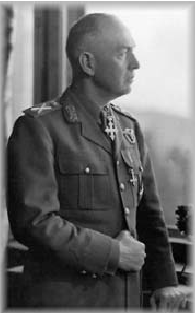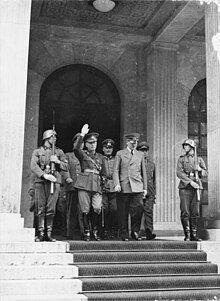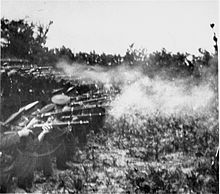Ion Antonescu
Ion Victor Antonescu ( ; born June 15, 1882 in Piteşti , † June 1, 1946 in Jilava ) was a Romanian general , politician and dictator of the Kingdom of Romania from 1940 to 1944 during the Second World War .
From September 1940 to August 1944 he was under the designation "State Leader" ( Romanian : Conducător al Statului ) Prime Minister and Marshal of Romania and as such led Romania on the side of the Axis powers in the Second World War. From September 1940 to January 1941 he first established the regime of the “National Legionary State” in alliance with the fascist legionnaires ' movement, and after the elimination of the legionnaires, finally a purely military dictatorship .
Under the Antonescu government, hundreds of thousands of Jews fell victim to the Holocaust through massacres and ethnic cleansing carried out by the Romanian army or in labor camps . The responsibility of the Antonescu government also includes the deportation of around 25,000 Roma (→ Porajmos ). Between 11,000 and 20,000 of the 25,000 died from hunger, cold, illness and other conditions of shortage.
Antonescu was overthrown in the royal coup in 1944 and executed two years later. Relativizations of Antonescu's role in World War II are carried out in Romania up to the present day by the nationalist and fascist camp.
Life
Until 1940
Antonescu came from a small family. The general staff officer was instrumental in the defense of the Moldova from 1917 in World War I. In 1933 he was appointed Chief of Staff of the Romanian Army .
In 1937 he was a Minister of Defense in the government of Prime Minister Octavian Goga . During the royal dictatorship of Carol II in 1938, he remained briefly in office under Goga's successor Miron Cristea , but was dismissed that same year. On July 9, 1940, he was imprisoned for two days, but was finally released again at German instigation. After the loss of territory to the Soviet Union and the cession of territory to Hungary enforced by the German Reich ( Second Vienna Arbitration ), Carol II's government came to an end in 1940. While the military increasingly vigorously demanded an attack on Hungary, the fascist Iron Guard attempted a coup on September 3, 1940. In this situation, Carol II appointed Antonescu Prime Minister with unlimited powers on September 4th, practically dictator. Antonescu immediately used his good contacts with the Iron Guard, with their support, to force Carol to abdicate on September 6th. He was succeeded Carol's son Michael I on.
Prime Minister
Antonescu initially ruled with the help of the Iron Guard in a dictatorial style, from September 14th no longer as prime minister, but as “state leader”. When the Iron Guard attempted a coup against Antonescu in January 1941, the uprising was brutally suppressed and the movement broke off. From then on, Antonescu, who was appointed " Marshal of Romania" on August 23, relied almost exclusively on the military.
In terms of foreign policy, Antonescu had turned away from the Western powers in 1940, as he only expected effective support against the Soviet Union from National Socialist Germany . On October 12th the first German military instructors started their service in Romania, on November 23rd the country joined the three-power pact . Antonescu tried, however, to maintain Romania's sovereignty also vis-à-vis the Axis powers. On June 22, 1941, Romania entered the war against the Soviet Union on the German side . The first major defeat against the Soviet troops occurred in December 1942. Shortly before, the German military command had placed two front sections northwest and south of Stalingrad under Romanian command. These troops were almost completely wiped out by the Red Army .
Under Antonescu's rule, hundreds of thousands of Romanian and Ukrainian Jews were deported to the Romanian occupied area of Transnistria . The International Commission for Research into the Romanian Holocaust, or Wiesel Commission for short , named after its chairman, Nobel Peace Prize laureate Elie Wiesel , presented its final report at the end of 2004. It reports on between 280,000 and 380,000 murdered Jews and over 20,000 murdered Roma. During the military dictatorship of Antonescu, several thousand Jews were able to emigrate to Palestine, where they had to buy themselves out of the Romanian state.
The military failures worsened both the relationship between Antonescu and King Michael I and with the leadership of National Socialist Germany. From the end of 1942 onwards, Antonescu tolerated unofficial negotiations between Romanian politicians and the Western powers over a peace treaty, but insisted on the continuation of the alliance with the German Reich. When the military situation continued to deteriorate rapidly, secret contacts with the Soviet Union were established in 1944. The aim was to maintain the country's independence.
Fall and execution

When the Red Army launched Operation Jassy-Kishinev on August 20, 1944 for a major attack on Romania and broke through the German-Romanian front on the Vltava within a very short time , Antonescu was defeated on August 23, 1944 by an opposition bloc (consisting of The National Peasant Party, the National Liberal Party, the Social Democratic Party and the Communist Party) overthrown with the support of the king and arrested by Soviet agents. Michael I declared war on Germany on August 25, 1944.
In September 1944 Antonescu was first extradited to the Soviet Union and brought back to Romania in April 1946. According to Article 14 of the Armistice Agreement of September 12, 1944 with Romania, the Allied Control Commission , chaired by the Soviet Union, had two people's courts of justice set up in Cluj and Bucharest to judge war crimes and crimes against humanity in Romania. On May 17, 1946, Antonescu was sentenced to death by shooting as a war criminal by the People's Court in Bucharest . The sentence was on June 1, 1946 at 18:06 in jail Fort 13 in Jilava enforced . With him, three of his closest collaborators, including the former Foreign Minister Mihai Antonescu (not related to Ion Antonescu) and the governor of the Romanian-administered Transnistria Province , Gheorghe Alexianu , were shot.
Bourgeois politicians were also invited to witness the trial, for example Iuliu Maniu , the chairman of the National Peasant Party, PNȚ , which was banned until 23 August 1944 .
Antonescu, who had given himself the title of marshal , let himself be described as a "leader of the state" ("Conducător al Statului"). The communist dictator Nicolae Ceaușescu was later also referred to as a "conducător" (leader).
marriage
Antonescu was married to Maria from 1928 until his death (born November 3, 1892 in Calafat , † October 18, 1964 in Bucharest), daughter of Army Captain Teodor Niculescu and his wife Anghelina. After his execution, his widow spent several years in prison and later in exile.
Post-socialist Antonescu cult
As early as 1975, during the time of the regime under Nicolae Ceaușescu, the first attempts at a "literary rehabilitation" of Antonescu were made. In the post-communist era, numerous politicians are calling for his rehabilitation. In some newspapers Antonescu was referred to as an " anti-Bolshevik hero". The newspaper Adevărul denied the Romanian participation in the Holocaust on July 11, 1991 and described Antonescu as a "tragic hero", as did the ultra-nationalist organization Vatra Românesca ( German Romanian homestead ) a few days later. The magazine Revista de istorie militară published in its issue no. 1/1991 an Antonescu picture on its cover and described him as “a brilliant figure in the history of our people”. Other newspapers reported profusely on his heroic deeds during the “holy anti-Bolshevik war” on the side of National Socialist Germany. Historians, history revisionists , TV presenters, TV stations, journalists, newspapers, courts and leading politicians in the country are still engaged in heated and controversial discussions and debates that extend to Holocaust denial.
In June 1991, Parliament honored Antonescu with a minute's silence. Only the representatives of the Hungarian minority left the room in protest against “this posthumous glorification”. In several Romanian cities, streets and squares were named after Antonescu with bipartisan sympathy from the 1990s to the early 2000s, and numerous monuments were placed on him. The military cemetery of Lețcani near Iași is named Antonescus. Under pressure from western countries, the rehabilitation process of the controversial dictator was discontinued, but the propaganda in favor of Antonescu continued unabated. A poll published in May 1995 confirmed that 62 percent of Romanians were positive about Antonescu. In 1999, the Romanian parliament honored Antonescu in a ceremony, and several MPs called for his rehabilitation, including Ioan Moisin .
In 2002, the Romanian government banned the establishment of neo-fascist, racist or xenophobic organizations by means of Emergency Ordinance 31/2002, as well as naming streets after war criminals or fascists, erecting statues or placing memorial plaques for people guilty of crimes against humanity or peace have made. The government finally asked the municipalities to rename all Antonescu streets by May 15, 2002 and to remove all existing monuments and memorial plaques. However, a picture of Antonescu was hung in the corridor of the government building, "to complete the collection of paintings of the Romanian Prime Minister". According to Romanian press reports, by the beginning of September 2002 only 10 of the 25 existing Antonescustraße were renamed.
President Traian Băsescu finally ratified the Emergency Ordinance 31/2002 as law on April 26, 2006. The law prohibits right-wing extremist propaganda and the establishment of neo-fascist, racist or xenophobic organizations. Membership in such organizations and the distribution, possession or use of fascist, racist or xenophobic symbols are also punishable by imprisonment. Holocaust denial is also punished with imprisonment of up to 5 years.
President Băsescu then declared on October 2, 2006, as a guest on the Bucharest broadcaster Realitatea-TV , that Antonescu was a “relatively brilliant officer”. His biggest mistake was to cross the Dniester - that is, Romania's participation in the war against the Soviet Union - added the head of state, without mentioning the extermination of Jews, Roma and others ordered by Antonescu.
The Adevărul newspaper reported on February 19, 2007 that a Bucharest court had partially overturned the post-war judiciary sentences against Ion Antonescu and 22 of his ministers. The controversial court decision had already been made on December 5, 2006, but details were only now known.
The results of a survey were published on October 9, 2007, from which it emerged that 66 percent of those questioned only associated the Holocaust with the atrocities committed in the Third Reich . 46 percent of those questioned saw Antonescu as a “great patriot” and 44 percent as a “great strategist”. Around a third of those questioned believed that Antonescu needed rehabilitation in recognition of his achievements for Romania. Twenty-four percent of respondents said Antonescu was a “democratic leader,” while 27 percent disagreed.
The Supreme Court of Justice and Cassation Court ( Romanian Înalta Curte de Casație și Justiție ) upheld the public prosecutor's objection on May 6, 2008 and lifted the partial rehabilitation of Antonescu and 20 of his closest collaborators, ordered by the Bucharest Court of Appeal in December 2006 .
At the beginning of March 2009, the Wiesel Commission asked the prefect of Neamț County to revoke Ion Antonescu's posthumous honorary citizenship of the city of Piatra Neamț . Antonescu received the title of honorary citizen in 1999. An Antonescu memorial was erected in Piatra Neamț as early as 1994, but it was razed in 2002. In the same year the Antonescu Square was renamed Piața Gării ( German station square ). The city council revoked Antonescu's honorary citizenship on April 29, 2009.
On January 16, 2010, a requiem for the “legionary heroes” who died in the Spanish Civil War on January 13, 1937 , was held in Bucharest's Ilie Gorgani Church . A memorial service on the occasion of the same anniversary took place on January 9, 2010 in the Biserică din groapa ("Church in the moat") in Sibiu (Hermannstadt). The two priests Gheorghe Bogdan ( Greek Catholic ) and Constantin Mitea ( Romanian Orthodox ) referred in their sermon to the need to “keep the flame of Christianity and Romanian nationalism alive”.
rating
The historian Hannelore Baier spoke of a “myth of national innocence” that was spread in the media, in class, by parliament and the government - with a few exceptions: “Romania did not take part in the Holocaust.” As a result, there has been no government so far Admitted responsibility for the deportation of Jews and Roma to Transnistria. In contrast, attempts are increasingly being made to politically rehabilitate Antonescu. He is celebrated as a “good patriot”, as a “fighter for the reunification of the country” and stylized as a “martyr”.
literature
Biographies
- Dennis Deletant: Hitler's Forgotten Ally: Ion Antonescu and His Regime, Romania, 1940-1944. Palgrave, 2006.
further reading
- Sebastian Balta: Romania and the Great Powers in the Antonescu Era (1940–1944) . Stuttgart 2005 (= sources and studies on the history of Eastern Europe, 69), 540 pp., ISBN 3-515-08744-3 .
- Armin Heinen : The Archangel Michael Legion in Romania - Social Movement and Political Organization: A Contribution to the Problem of International Fascism . Munich, 1986, ISBN 3-486-53101-8 .
- Mariana Hausleitner : The Romanization of Bukowina 1918–1944. The enforcement of the nation-state claim of Greater Romania . Munich 2001.
- Mariana Hausleitner: Major crimes in Romanian Transnistria 1941–1944 . In: Mariana Hausleitner et al. (Ed.): Romania and the Holocaust. On the mass crimes in Transnistria 1941–1944 . Metropol, Berlin 2001, pp. 15-24.
- Mariana Hausleitner: Anti-Semitism in Romania before 1945. In: Hermann Graml et al. (Ed.): Prejudice and Racial Hatred. Anti-Semitism in the fascist movements in Europe . Berlin 2001, pp. 169-178.
- Andreas Hillgruber : Hitler, King Carol and Marshal Antonescu: The German-Romanian. Relationships 1938-1944 . 2nd edition Wiesbaden: F. Steiner 1965.
- Andreas Hillgruber: Antonescu, Ion . In: Biographical Lexicon on the History of Southeast Europe . Volume 1. Munich 1974, pp. 81-83.
- Nicholas M. Nagy-Talavera: The Green Shirts and the Others. A History of Fascism in Hungary and Romania . Stanford 1970.
- William Totok : Cyberspace delegates. Romanian post-fascism on the internet . In: Half-yearly publication for Southeast European history, literature and politics . 9th vol., No. 1/1997, pp. 7-23.
- William Totok: The Revisionist Discourse . In: Semi-annual publication for Southeast European History, Literature and Politics (abbreviated: HJS), Vol. 10, No. 1/1998, pp. 45–67. (Romanian version: Discursul revizionist , in Sfera Politicii (Supliment), No. 1/1998, pp. 26–32.)
- William Totok: Antonescu - a sacrifice on the altar of democracy? Right-wing radicalism and revisionism in Romania (I). In: HJS , Volume 13, No. 2/2001, pp. 33-57 (short version in: Ost-West-Gegeninformationen , Volume 13, No. 2/2001, pp. VI-XV; Romanian version: Antonescu sacrificat pe altarul diplomației , in: Observator Cultural , No. 74, 75, 76 and 77/2001 ).
- William Totok: A racist concoction. Right-wing radicalism and revisionism in Romania (II), in: HJS , 14th year, No. 1/2002, pp. 55–72.
- William Totok: Mystifications, Adulterations and Twists. Right-wing radicalism and revisionism in Romania (III). In: HJS , 14th year, No. 2/2002, pp. 19–42 (Romanian version: Mistificări și falsificări. Contrareacții la Ordonanță , in: Observator Cultural, No. 152 / 21.01. –27.012003. And: O nouă dimensiune a revizionismului din Româia , in: Observator Cultural, No. 115 / 07.05-13.05 2002).
- William Totok: Walking the tightrope between coming to terms with the past and twisting it. Right-wing radicalism and revisionism in Romania (IV). In: HJS , Vol. 15, No. 1/2003, pp. 44-64.
- William Totok: Historical intermeshing. Right-wing radicalism and revisionism in Romania (V). In: HJS , Vol. 15, No. 2/2003, pp. 54-76.
- William Totok: "Shoot these wicked". Right-wing radicalism and revisionism in Romania (VI). In: HJS , Volume 16, No. 1/2004, pp. 35-53.
- William Totok: The Topicality of the Past. Right-wing radicalism and revisionism in Romania (VII). In: HJS , Volume 16, No. 2/2004, pp. 25-40.
- William Totok: The Internet as a Virtual International . In: Die Neue Gesellschaft / Frankfurter Hefte , Volume 48, No. 4 / April 2001, pp. 216–220.
Web links
- Literature by and about Ion Antonescu in the catalog of the German National Library
- Newspaper article about Ion Antonescu in the 20th century press kit of the ZBW - Leibniz Information Center for Economics .
- Final report of the International Commission for Research into the Romanian Holocaust, 2004 (English / Romanian)
- The Antonescu case - news, analyzes, reports, articles and studies that were published after 1990 about Antonescu in Romania, Germany, Hungary, France, the USA and others. Countries have appeared
- The execution of Antonescu
Individual evidence
- ^ Viorel Achim: Gypsy Research and Gypsy Policy in Romania 1920-1950. In: Michael Zimmermann (ed.): Between education and destruction. Gypsy Politics and Gypsy Research in Europe in the 20th Century . Franz Steiner, Stuttgart 2007 ( Contributions to the History of the German Research Foundation , Vol. 3), pp. 157–174.
- ^ Antonescu dictatorship 1940 to 1944, Süddeutsche Zeitung, accessed on September 16, 2012, 4:27 pm
- ↑ Annette Schaefgen: Romania and the Holocaust. On the mass crimes in Transnistria 1941–1944. In: News Letter , Technische Universität Berlin , September 16, 1999; see Radu Florian: The Antonescu Regime: History and Mystification. In: Randolph L. Braham (Ed.): The Tragedy of Romanian Jewry. (East European Monographs, No. CDIV) The Rosenthal Institute for Holocaust Studies / Columbia University Press, New York 1994, pp. 77-115.
- ^ Antonescu dictatorship 1940 to 1944, Süddeutsche Zeitung, accessed on September 16, 2012, 4:27 pm
- ^ Armistice agreement with Romania
- ↑ a b Halbjahresschrift.homepage.t-online.de , William Totok : Der Fall Antonescu - Cazul Antonescu , January 26, 2010
- ↑ Annette Schaefgen: Romania and the Holocaust. On the mass crimes in Transnistria 1941–1944. In: News Letter , Technische Universität Berlin , September 16, 1999; see Radu Florian: The Antonescu Regime: History and Mystification. In: Randolph L. Braham (Ed.): The Tragedy of Romanian Jewry. (East European Monographs, No. CDIV) The Rosenthal Institute for Holocaust Studies / Columbia University Press, New York 1994, pp. 77-115.
| personal data | |
|---|---|
| SURNAME | Antonescu, Ion |
| ALTERNATIVE NAMES | Antonescu, Ion Victor (full name); Antonescu, Jon |
| BRIEF DESCRIPTION | Romanian politician and chief of staff |
| DATE OF BIRTH | June 15, 1882 |
| PLACE OF BIRTH | Pitesti |
| DATE OF DEATH | June 1, 1946 |
| Place of death | Jilava |



